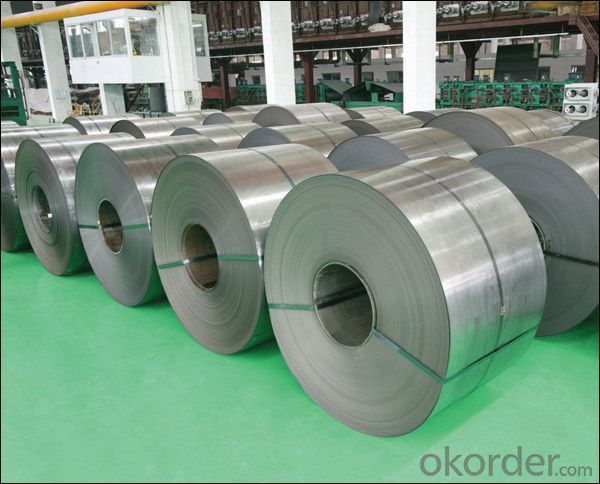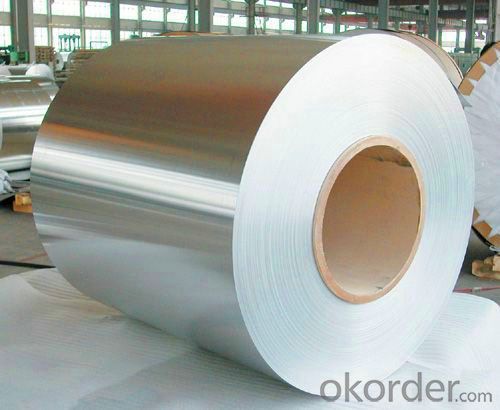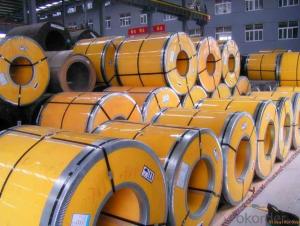Stainless Steel Coil 201 Hot Rolled Narrow Coil J1
- Loading Port:
- Lianyungang
- Payment Terms:
- TT OR LC
- Min Order Qty:
- 400 m.t.
- Supply Capability:
- 8000 m.t./month
OKorder Service Pledge
OKorder Financial Service
You Might Also Like
Hot Rolled Stainless Steel Coil 201 Narrow/Wide Strip No.1 Finish
Packaging Detail: For customer's requirement
Delivery Detail: 10-30days
201 Hot Rolled Stainless Steel Coil Specifications
THK:2.3/2.5/3.0/4.0mm
Width:485/510/550/610/1010/1240mm
Face:No.1
201 Hot rolled stainless steel Coil Application
Stainless steel is a production which not easy rust,acid resistance and corrosion resistance,so it is widely
used in light industry,heavy industry,daily necessities and the decoration industry.
201 Hot Stainless Steel Coil Chemical Composition(WT%)
(C):≤0.15, (Si):≤0.75, (Mn):5.5~7.50, (Cr):16.0~18.0, (N):≤0.25, (Ni):3.50~5.50, (P):≤0.060, (S):≤0.030
201 Hot Rolled Stainless Steel Coil
Strength Of Extension:100,000 To 180,000 Psi;
Yield Strength:50,000 To 150,000 Psi
Elongation :55 To 60%;
Modulus Of Elasticity:29,000,000 Psi;
Density :.280lbs/Cubic Inch(7.93g/Cm3)




- Q:How are stainless steel strips made?
- The production of stainless steel strips involves a technique called cold rolling, wherein a stainless steel coil is passed through a set of rollers at room temperature. This action progressively reduces the thickness and increases the length of the coil. To begin, the stainless steel coil is unwound and cleaned to eliminate any dirt or impurities. Subsequently, it is subjected to a series of rolling mills where the thickness is gradually decreased. These mills consist of two or more rollers that apply pressure to the metal, causing it to elongate and become thinner. This process is repeated until the desired thickness is achieved. As the stainless steel strip becomes thinner, it becomes more rigid and challenging to handle. To counteract this issue, annealing is conducted at specific intervals during the rolling process. Annealing involves heating the strip to high temperatures and slowly allowing it to cool. This procedure helps alleviate internal stresses and enhance the strip's ductility. Following the cold rolling and annealing stages, the stainless steel strip may undergo additional treatments such as descaling, pickling, and passivating. Descaling eliminates any scales or oxides that may have formed on the strip's surface during rolling. Pickling involves treating the strip with an acid solution to eliminate any remaining impurities. Passivation is the final step, in which a thin, protective oxide layer is formed on the surface of the stainless steel, enhancing its corrosion resistance. Once all of these processes are completed, the stainless steel strip is cut to the desired length and packaged for shipment or further processing. Its exceptional strength, durability, and resistance to corrosion make it suitable for a wide range of applications, including automotive components, kitchen appliances, construction materials, and electronic devices.
- Q:What are the different types of surface textures for stainless steel strips?
- Stainless steel strips offer a range of surface textures, each with its own distinct qualities and visual appeal. Let's explore a few common options: 1. No.1 Finish: The most basic and widely used texture, it has a rough, dull appearance. It is created by hot rolling and is commonly used in industrial settings where appearance is not a priority. 2. No.2B Finish: Achieved through hot and cold rolling with annealing, it has a smooth, reflective look with a slightly less shiny finish than No.1. No.2B is popular in kitchen appliances, architectural components, and decorative applications. 3. No.4 Finish: Also called satin or brushed finish, it involves mechanical polishing with abrasives. This creates a consistent, linear appearance with low reflectivity. No.4 is favored in architectural and interior design for decorative purposes. 4. BA (Bright Annealed) Finish: Obtained through bright annealing, it enhances corrosion resistance and offers a highly reflective, mirror-like appearance. BA finish is ideal for applications where reflectivity and aesthetics are important, like automotive trim and decorative items. 5. No.8/Mirror Finish: The highest quality and most reflective texture, it undergoes a multi-step process of grinding, polishing, and buffing. This results in a flawless, mirror-like look. No.8 is commonly used in luxury architectural projects, high-end decorative applications, and luxury goods. These examples represent just a few of the surface textures available for stainless steel strips. The choice depends on specific requirements, including aesthetics, functionality, and durability.
- Q:Are 111 stainless steel strips resistant to scaling at elevated temperatures?
- 111 stainless steel strips exhibit resistance to scaling at elevated temperatures. Due to its composition and properties, 111 stainless steel is highly resistant to oxidation and scaling when exposed to high temperatures. This stainless steel variant contains a greater proportion of chromium, which generates a protective oxide layer on the strip's surface. This oxide layer functions as a shield, inhibiting the steel from reacting with oxygen and other atmospheric elements. Consequently, the integrity of the 111 stainless steel strips remains intact, enabling them to withstand scaling even under elevated temperature conditions.
- Q:What are the advantages of using stainless steel strips in the automotive industry?
- There are several advantages of using stainless steel strips in the automotive industry. Firstly, stainless steel is highly resistant to corrosion, which makes it ideal for use in vehicles that are exposed to harsh weather conditions and road salt. This helps prolong the lifespan of automotive components, reducing maintenance and replacement costs. Secondly, stainless steel strips offer excellent strength and durability, allowing them to withstand high levels of stress and impact. This makes them suitable for various applications in the automotive sector, such as structural supports, exhaust systems, and body panels, enhancing vehicle safety and performance. Furthermore, stainless steel strips have a sleek and attractive appearance, enhancing the aesthetics of automotive components. Their ability to retain a polished finish even after prolonged use adds to the overall appeal of vehicles. Lastly, stainless steel is a sustainable and eco-friendly material. It is fully recyclable, contributing to the reduction of waste and environmental impact in the automotive industry. Overall, the advantages of using stainless steel strips in the automotive industry include corrosion resistance, strength and durability, aesthetic appeal, and sustainability.
- Q:What are the factors affecting the corrosion resistance of 111 stainless steel strips?
- There are several factors that can affect the corrosion resistance of 111 stainless steel strips. 1. Composition: The composition of the stainless steel plays a crucial role in its corrosion resistance. The presence of alloying elements such as chromium, nickel, and molybdenum can enhance the corrosion resistance of the steel. In the case of 111 stainless steel, it typically contains 17-19% chromium, which provides excellent corrosion resistance. 2. Surface condition: The surface condition of the stainless steel strips can impact its corrosion resistance. Any imperfections, such as scratches, roughness, or contamination, can create sites for corrosion initiation. Therefore, proper surface preparation and cleaning are essential to maintain the corrosion resistance of the strips. 3. Environmental factors: The environment in which the stainless steel strips are exposed can significantly affect their corrosion resistance. Factors such as temperature, humidity, pH level, and the presence of corrosive substances like acids or chlorides can accelerate the corrosion process. Therefore, it is important to consider the specific environmental conditions in which the 111 stainless steel strips will be used. 4. Passive film formation: Stainless steel forms a passive oxide film on its surface, which provides a protective barrier against corrosion. The ability of the steel to form and maintain this passive film is crucial for its corrosion resistance. Any damage to the film can lead to localized corrosion. Therefore, factors such as exposure to aggressive chemicals or mechanical damage can affect the passive film formation and, consequently, the corrosion resistance. 5. Manufacturing processes: The way the stainless steel strips are manufactured can influence their corrosion resistance. Processes such as heat treatment, cold rolling, and surface finishing can affect the microstructure and surface properties of the steel, which in turn can impact its corrosion resistance. 6. Maintenance and care: Proper maintenance and care of the stainless steel strips can significantly extend their corrosion resistance. Regular cleaning, removal of contaminants, and applying protective coatings can help prevent corrosion and maintain the longevity of the strips.
- Q:Are stainless steel strips suitable for high-temperature oxidation?
- Yes, stainless steel strips are suitable for high-temperature oxidation. Stainless steel is known for its excellent resistance to oxidation and corrosion, making it an ideal choice for applications that involve high temperatures. The chromium content in stainless steel forms a protective oxide layer on the surface, which prevents further oxidation at elevated temperatures. This oxide layer acts as a barrier against the corrosive effects of oxygen and other elements, thereby ensuring the longevity and durability of stainless steel strips even in high-temperature environments. Additionally, stainless steel alloys with higher levels of chromium, nickel, and other alloying elements exhibit enhanced resistance to oxidation, making them particularly suitable for extremely high-temperature applications.
- Q:How do you clean stainless steel strips?
- To clean stainless steel strips, you can start by wiping them down with a soft cloth or sponge soaked in warm soapy water. For tougher stains or dirt buildup, you can use a non-abrasive cleaner specifically formulated for stainless steel. It's important to avoid using abrasive materials or harsh chemicals as they can damage the surface. After cleaning, make sure to rinse the strips thoroughly with water and dry them with a clean cloth to prevent water spots or streaks.
- Q:Are 111 stainless steel strips suitable for heat recovery systems?
- Yes, 111 stainless steel strips are suitable for heat recovery systems. Stainless steel is known for its high heat resistance and durability, making it an excellent choice for heat recovery applications.
- Q:Can stainless steel strips be used in high-temperature applications?
- Certainly! High-temperature applications can indeed utilize stainless steel strips. Renowned for its impressive heat resistance, stainless steel is capable of enduring elevated temperatures while maintaining both its strength and structural integrity. With a high melting point and minimal thermal expansion, stainless steel proves to be an excellent choice for environments characterized by heightened temperatures. Moreover, its resistance to oxidation and corrosion further enhances its aptness for high-temperature applications. Industries such as aerospace, automotive, chemical, and power generation frequently employ stainless steel strips in order to withstand extreme temperatures and challenging conditions.
- Q:What is the corrosion resistance of stainless steel strips?
- The corrosion resistance of stainless steel strips is excellent due to the presence of chromium in its composition, which forms a protective oxide layer on the surface, preventing rust and corrosion.
1. Manufacturer Overview |
|
|---|---|
| Location | |
| Year Established | |
| Annual Output Value | |
| Main Markets | |
| Company Certifications | |
2. Manufacturer Certificates |
|
|---|---|
| a) Certification Name | |
| Range | |
| Reference | |
| Validity Period | |
3. Manufacturer Capability |
|
|---|---|
| a)Trade Capacity | |
| Nearest Port | |
| Export Percentage | |
| No.of Employees in Trade Department | |
| Language Spoken: | |
| b)Factory Information | |
| Factory Size: | |
| No. of Production Lines | |
| Contract Manufacturing | |
| Product Price Range | |
Send your message to us
Stainless Steel Coil 201 Hot Rolled Narrow Coil J1
- Loading Port:
- Lianyungang
- Payment Terms:
- TT OR LC
- Min Order Qty:
- 400 m.t.
- Supply Capability:
- 8000 m.t./month
OKorder Service Pledge
OKorder Financial Service
Similar products
New products
Hot products
Related keywords






























